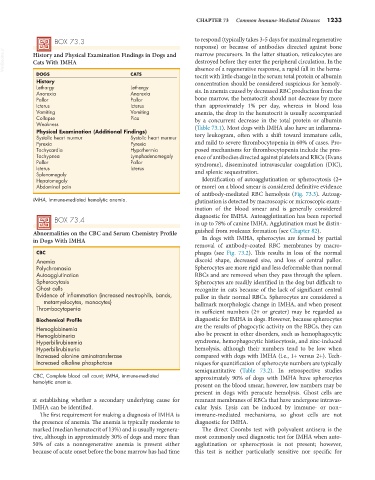Page 1261 - Small Animal Internal Medicine, 6th Edition
P. 1261
CHAPTER 73 Common Immune-Mediated Diseases 1233
BOX 73.3 to respond (typically takes 3-5 days for maximal regenerative
response) or because of antibodies directed against bone
VetBooks.ir History and Physical Examination Findings in Dogs and marrow precursors. In the latter situation, reticulocytes are
destroyed before they enter the peripheral circulation. In the
Cats With IMHA
DOGS CATS absence of a regenerative response, a rapid fall in the hema-
tocrit with little change in the serum total protein or albumin
History concentration should be considered suspicious for hemoly-
Lethargy Lethargy sis. In anemia caused by decreased RBC production from the
Anorexia Anorexia
Pallor Pallor bone marrow, the hematocrit should not decrease by more
Icterus Icterus than approximately 1% per day, whereas in blood loss
Vomiting Vomiting anemia, the drop in the hematocrit is usually accompanied
Collapse Pica by a concurrent decrease in the total protein or albumin
Weakness (Table 73.1). Most dogs with IMHA also have an inflamma-
Physical Examination (Additional Findings)
Systolic heart murmur Systolic heart murmur tory leukogram, often with a shift toward immature cells,
Pyrexia Pyrexia and mild to severe thrombocytopenia in 60% of cases. Pro-
Tachycardia Hypothermia posed mechanisms for thrombocytopenia include the pres-
Tachypnea Lymphadenomegaly ence of antibodies directed against platelets and RBCs (Evans
Pallor Pallor syndrome), disseminated intravascular coagulation (DIC),
Icterus Icterus and splenic sequestration.
Splenomegaly
Hepatomegaly Identification of autoagglutination or spherocytosis (2+
Abdominal pain or more) on a blood smear is considered definitive evidence
of antibody-mediated RBC hemolysis (Fig. 73.3). Autoag-
IMHA, Immune-mediated hemolytic anemia. glutination is detected by macroscopic or microscopic exam-
ination of the blood smear and is generally considered
diagnostic for IMHA. Autoagglutination has been reported
BOX 73.4 in up to 78% of canine IMHA. Agglutination must be distin-
Abnormalities on the CBC and Serum Chemistry Profile guished from rouleaux formation (see Chapter 82).
in Dogs With IMHA In dogs with IMHA, spherocytes are formed by partial
removal of antibody-coated RBC membranes by macro-
CBC phages (see Fig. 73.2). This results in loss of the normal
Anemia discoid shape, decreased size, and loss of central pallor.
Polychromasia Spherocytes are more rigid and less deformable than normal
Autoagglutination RBCs and are removed when they pass through the spleen.
Spherocytosis Spherocytes are readily identified in the dog but difficult to
Ghost cells recognize in cats because of the lack of significant central
Evidence of inflammation (increased neutrophils, bands, pallor in their normal RBCs. Spherocytes are considered a
metamyelocytes, monocytes) hallmark morphologic change in IMHA, and when present
Thrombocytopenia in sufficient numbers (2+ or greater) may be regarded as
Biochemical Profile diagnostic for IMHA in dogs. However, because spherocytes
Hemoglobinemia are the results of phagocytic activity on the RBCs, they can
Hemoglobinuria also be present in other disorders, such as hemophagocytic
Hyperbilirubinemia syndrome, hemophagocytic histiocytosis, and zinc-induced
Hyperbilirubinuria hemolysis, although their numbers tend to be low when
Increased alanine aminotransferase compared with dogs with IMHA (i.e., 1+ versus 2+). Tech-
Increased alkaline phosphatase niques for quantification of spherocyte numbers are typically
semiquantitative (Table 73.2). In retrospective studies
CBC, Complete blood cell count; IMHA, immune-mediated approximately 90% of dogs with IMHA have spherocytes
hemolytic anemia.
present on the blood smear; however, low numbers may be
present in dogs with peracute hemolysis. Ghost cells are
at establishing whether a secondary underlying cause for remnant membranes of RBCs that have undergone intravas-
IMHA can be identified. cular lysis. Lysis can be induced by immune- or non–
The first requirement for making a diagnosis of IMHA is immune-mediated mechanisms, so ghost cells are not
the presence of anemia. The anemia is typically moderate to diagnostic for IMHA.
marked (median hematocrit of 13%) and is usually regenera- The direct Coombs test with polyvalent antisera is the
tive, although in approximately 30% of dogs and more than most commonly used diagnostic test for IMHA when auto-
50% of cats a nonregenerative anemia is present either agglutination or spherocytosis is not present; however,
because of acute onset before the bone marrow has had time this test is neither particularly sensitive nor specific for

